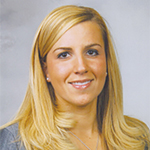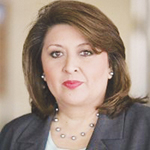"If you want to go fast, go alone; but if you want to go far, go together."

A CHRISTUS Health leader cited this proverb to explain the impetus behind a collaboration of San Antonio organizations to address pressing health and social needs in this southeast Texas community of more than a million people. During a recent webinar, that leader — Sarah Hetue Hill — and others heading the collaborative described how the group has evolved its work.
"We're in a unique position to create change with our unified voice, as Catholic health leaders with other leaders. We are leaning in, assessing community needs and leveraging our voices to address health inequities" and to work toward eliminating racism, Hill said during the Nov. 9 CHA webinar. She is regional vice president of mission integration for CHRISTUS Santa Rosa Health System and CHRISTUS Children's Hospital.
The webinar — "Transforming Health Care Together: The San Antonio Health Collaborative Story" — was part of CHA's We Are Called webinar series. We Are Called is CHA's wide-ranging push toward health equity, which CHA members are pursuing through the Confronting Racism by Achieving Health Equity Pledge.
The San Antonio Health Collaborative creates a community health needs assessment and community health improvement plan for Bexar County, Texas. It also founded a hub to identify and address needs of individual community members. Hill said the collaborative is an example of what can be done when even "fierce competitors come together to tackle an issue." She said the ever-expanding group of partners is helping improve the health outcomes of vulnerable people.
Dennis Gonzales, CHA senior director of mission integration and innovation, told Catholic Health World that the collaborative stands out nationally in that competing health systems in a large city are successfully working together.
"If it can happen there, it can be done anywhere," said Gonzales.
Visionary leader
Hill explained that the collaborative came about because Sr. Michele O'Brien, CCVI, of a CHRISTUS co-sponsor, the Sisters of Charity of the Incarnate Word of San Antonio, lamented in the late 1990s that there were many community needs, and health and social service providers seemed to be "working in silos," addressing those needs in a fragmented way. Sr. O'Brien, who Hill called visionary for her foresight, approached other organizations in the community and in 1997 had enough buy-in to launch the group. In 2020 the group became a formal nonprofit, the Health Collaborative of San Antonio.
Webinar presenter Elizabeth Lutz, CEO of the collaborative, said since its formation a governing board representing its members has been determining how the collaborative should prioritize its work. Hill is Health Collaborative board chair. Other members include representatives of Baptist Health, University of the Incarnate Word, Our Lady of the Lake University, Methodist Healthcare, Methodist Healthcare Ministries of South Texas, Community First Health Plans, Bexar County, the San Antonio Metro Health Department, University Health of San Antonio, and the University of Texas Health Science Center. A community member who is not affiliated with any particular partner organization also is on the board.
Beginning in 2010 the group began creating a single community health needs assessment and community health improvement plan for Bexar County.
Central hub
In 2018, Lutz explained, the collaborative's board decided to take on the root causes of community members' health and social concerns in a holistic way.
So the collaborative founded the Grow Healthy Together community hub, which in 2020 became the first Texas organization certified by the Pathways Community HUB Institute. The institute equips communities across the U.S. to provide health and social service navigation help to vulnerable community members.
With the help of staff from various organizations, the Grow Healthy Together hub locates community members in need of service navigation help. Community health workers assess the individuals' needs and connect them with the resources, information, services and/or referrals they require. The hub also measures the impact of the services that have been provided on individuals' lives.
At its inception, the hub relied heavily on grant dollars. Now it is funded largely through health system participant annual dues and contracts the hub secures with insurance companies and other organizations that reimburse for health care services. Those companies determine which populations within their client base are most in need, connect the hub with those clients and then pay the hub when "pathways" of need are completed. Some fees go into a general fund that the hub maintains to cover the costs of aiding clients who are not insured by participating payers.
The incentive for the payers is to keep their clients out of expensive emergency departments by taking care of those clients' social needs. If their social needs are left unmet, people may destabilize and end up in the emergency department, the logic goes.
Closing the loop
Esmeralda "Mela" Perez, who directs community services for CHRISTUS Santa Rosa and CHRISTUS Children's Hospital, explained that when the hub's community health workers engage with their clients, they first learn what their clients' needs are, and that enables the community health workers to set up pathways, or steps to take to address clients' needs. The community health workers must resolve the needs to close the loop on the pathways.

For instance, if a community health worker identifies hunger as a need, that worker might connect the client with the Supplemental Nutrition Assistance Program, helping that client apply for a SNAP card, teaching the client to use the card and making sure the client is then using the card successfully. At that point, the loop is closed for that pathway. As new needs — such as transportation, housing, utilities and financial aid — emerge, the community health worker opens new pathways. As the worker closes the pathways, the hub is paid for its services.
Hub workers have a physical presence in local emergency departments and social service agencies and are available by phone to their clients. The hub has helped more than 5,500 clients since its inception several years ago.
Between the work of the collaborative and the hub, community members can get assistance with care coordination, financial literacy, housing, health literacy, health insurance access, prenatal care, diabetes education, food security, mental health and COVID education, among other services. A current focus of the collaborative and hub is to ensure people do not become uninsured during Medicaid redetermination.
Minding the gaps
Webinar presenters said the collaborative has returned numerous benefits for its participants, clients and the broader community.
Health and social service organizations are more efficiently and effectively meeting the needs of county residents — and the geographic breadth of their work is expanding beyond Bexar County. The hub's work is returning data on gaps in services locally, which is helping the collaborative and others to think through how those gaps could be closed. And residents are becoming more empowered to gain stability in their lives, said webinar presenters.
Hill said the collaborative enforces accountability for outcomes, has achieved increased equity in the delivery of services, has promoted the common good, and has seen people's well-being improve. "People are flourishing," she said.
Learn about CommonSpirit Health's use of the Pathways model.
